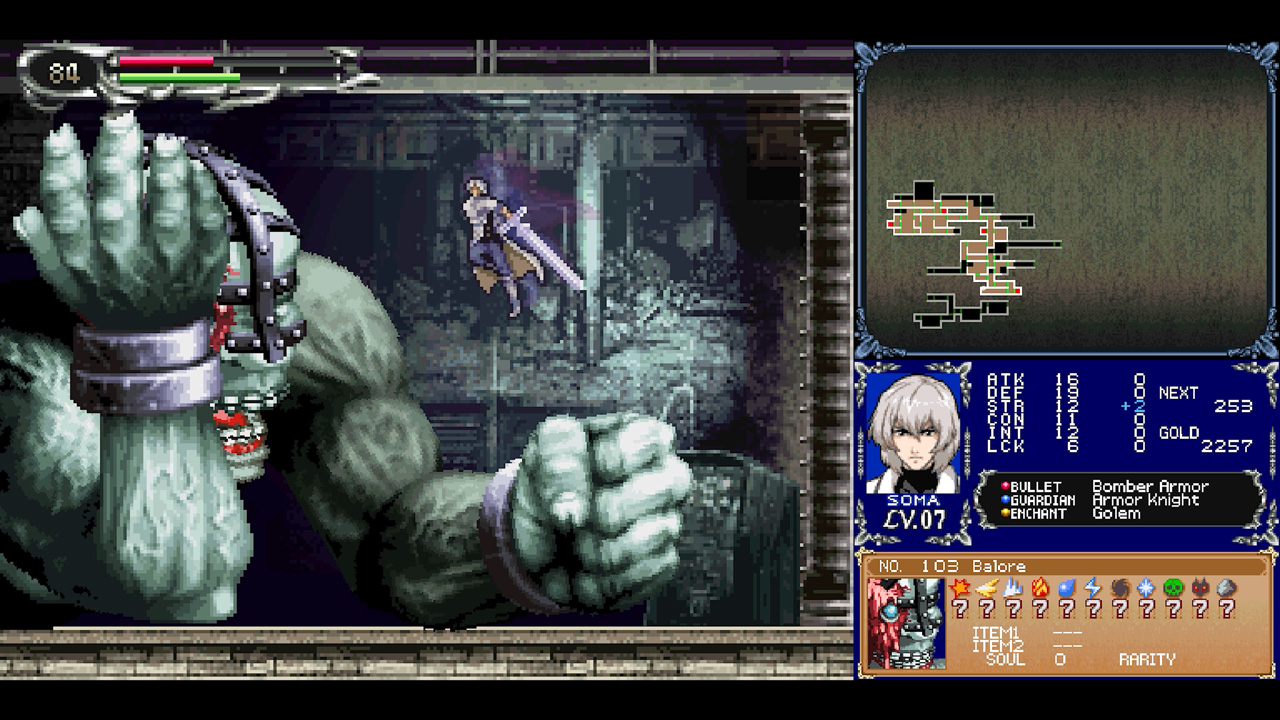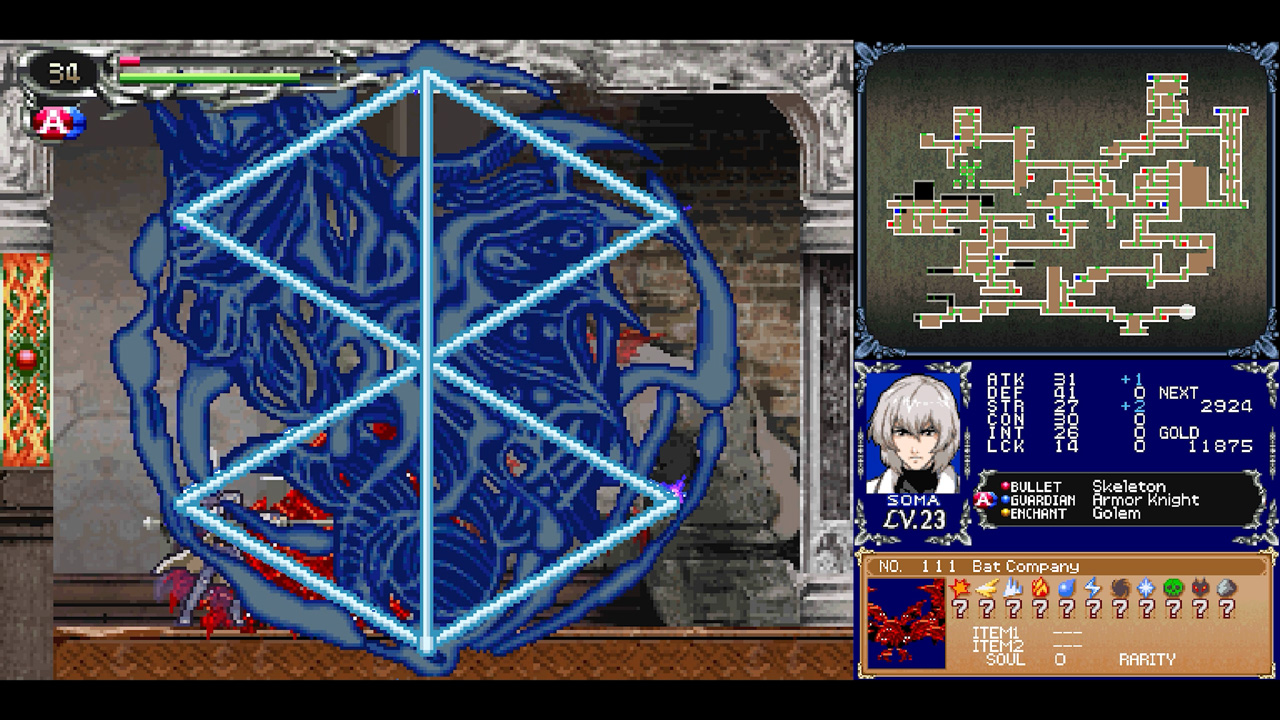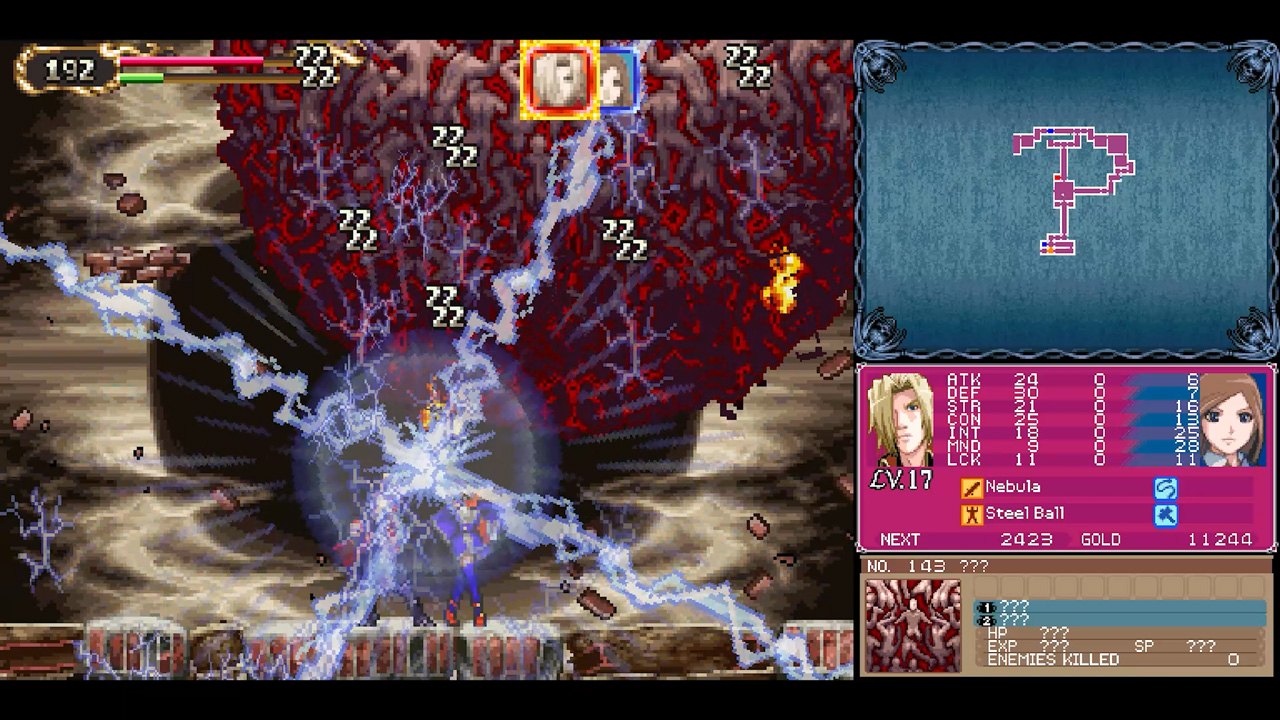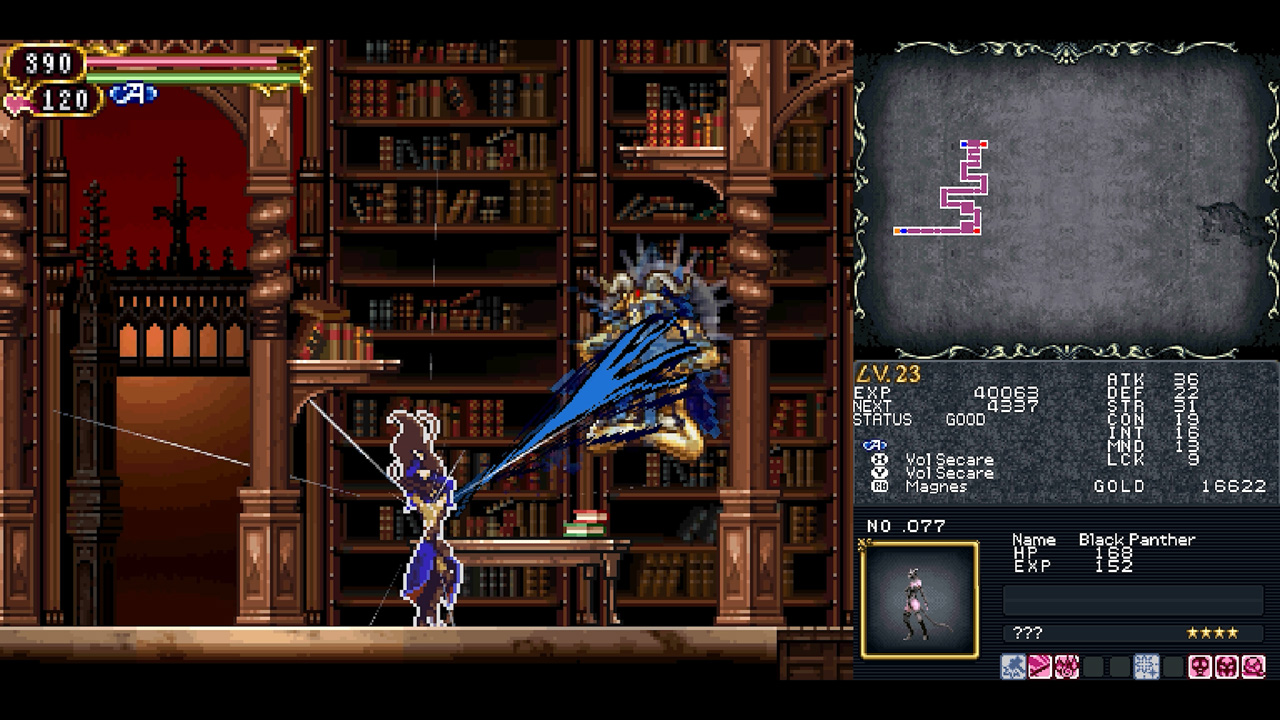System: Switch
Release date: August 27, 2024
Developer: Konami
Publisher: Konami
Since the surprise release of Castlevania Advance Collection I’ve had the question “are we getting a port of the DS titles?” sitting in the back of my mind and surfacing to the forefront every time a Nintendo Direct aired. Of course bringing the DS titles across to the Switch wouldn’t be as simple a task, so it is perhaps understandable that it’s taken three years for Castlevania Dominus Collection to finally make it onto the system. However, now that it’s finally here, the end result is more than worth the wait.
Dominus Collection brings together the three Castlevania titles that were released on DS: Dawn of Sorrow, Portrait of Ruin, and Order of Ecclesia. All three had a layout that made them much more approachable than their Game Boy Advance predecessors at the time, utilizing the top screen of the DS for map display or character stats, and the bottom screen for gameplay. This made exploration of the vast, sprawling castles much more streamlined than before, bypassing the need to check your characters’ stats every few minutes or try and figure out where you were in relation to where you thought you needed to be.
Dominus Collection gives you several different options for display to replicate this convenience, even going so far as to give you the option to split the top screen data into two screens at once alongside a third, larger screen for the gameplay. The classic DS look is also an option if you’re feeling particularly nostalgic. No matter which option you choose things can feel a little cramped if you’re playing handheld, and the map screen in particular suffers if you use the triple screen option. Regardless of which option you choose, the main gameplay screen is always clear and crisp, with the visuals rendered quite nicely in higher resolution, and you can swap between modes at any time in the pause menu if you find that your current settings aren’t to your liking.
Outside of the games themselves, there are a plethora of extra features included: concept art and instruction manuals in multiple languages, a complete compendium of items and enemies (which you can ironically view at any time during gameplay, entirely separate from the in-game compendium you need to fill in yourself), and a music player being notable highlights. The level of quality and breadth of content in Dominus Collection is easily on par with any previous Konami collections, and a welcome inclusion to the package that fans will no doubt appreciate.
Looking at the games individually, they each have their own unique quirks to set them apart despite sharing that core Metroidvania experience. All three have aged remarkably well and are extremely accessible on Switch, with the ability to remap controls being extremely useful: if you’ve played any Metroidvania title on the system and are more comfortable with a different control scheme, you’ll be able to replicate it to some extent in Dominus Collection.
Dawn of Sorrow, the first of the three that was released, acts as a direct sequel to Aria of Sorrow, and is the most narrative-focused of the three. Its status as a direct sequel means that it relies heavily on events from the prior game, so if you haven’t played Aria of Sorrow it’ll likely be an unsatisfying experience on this front. The story plays out in the short, infrequent cutscenes that are the standard for the Metroidvania genre, and it never takes the time to properly explain the motivations of the antagonists or who the various other characters are and why they’re important.
The new anime-style artwork used for Dawn of Sorrow’s character portraits is also notably less appealing than Ayami Kojima’s original work in Aria of Sorrow, and feels like a somewhat jarring shift that doesn’t capture the same gothic atmosphere that had defined the series since Symphony of the Night. These portraits are also stretched awkwardly at higher resolutions and look unpleasantly blurred. Fortunately, the visual design of the castle and enemies is the step-up you would expect from the hardware shift from GBA to DS with a greater level of detail that brings the more familiar locations in particular to life. It also revisits the partner system first introduced in Castlevania III: Dracula’s Curse with an unlockable Julius Mode, which has the added benefit of giving a different perspective on the narrative.
Dawn of Sorrow relied heavily on the DS’ features, and the touchscreen mechanics that defined the gameplay have been incorporated fully into the Switch version. Although the result is far from flawless, the options that have been included to make up for the lack of precision in your fingers when compared to a stylus make it a fantastic experience here. In the original version of the game you would need to draw seals to defeat bosses and, although you can still do this with the Switch’s touchscreen, the option to input a combination of buttons has been implemented. It is slightly less intuitive, but easier than trying to trace them with your finger after a little practice. You can also use a combination of the right control stick and buttons to draw on the screen if you’d prefer, bypassing the need for the touch screen entirely to do things such as destroying blocks. Using the mouse-style cursor feels significantly clunkier, but overall the result is a much better experience than I was expecting.
The next title, Portrait of Ruin, feels like a natural evolution of Dawn of Sorrow in many ways, despite dialing back significantly on the touchscreen mechanics to the point that you’d be forgiven for forgetting it was a DS title, although this is not necessarily a point against it. It doubles down on the partner system by giving you two playable protagonists in Jonathan and Charlotte who have their own distinct playstyles, with the former being a physical attacker and the latter being a mage. Although this doesn’t factor too much into how you’ll explore each area, it does open up some interesting options for combat with Charlotte in particular, as her best moves have moderate charge times and use MP, meaning you’ll need to be more careful with how and when you attack. You can also summon the character you’re not using to act in battle alongside you, although the AI means that they’ll be a distraction for the enemy at the best of times.
Portrait of Ruin feels more structured as a Metroidvania thanks to the portrait worlds that you’ll jump in and out of in order to progress, with the castle acting as more of a hub that will open up as you acquire new abilities from the portrait worlds. This also allows for a greater variety in locations without feeling too incongruous, and you’ll explore a nice mix of areas as a result of this. From a narrative standpoint the game acts as a direct sequel to Castlevania: Bloodlines, but this feels more like an Easter egg for fans familiar with the game than required knowledge like its predecessor. The story unfolds in the same brief cutscenes in-between the action, although it is slightly more impactful because you’ll need to do a little more work to uncover the full story and experience the game’s true ending, which is significantly different from the ending you’ll see if you play through the game without taking the time to explore.
Order of Ecclesia, the final game in the collection to be released, initially feels a great deal like the classic stage-based Castlevania titles. It’s a lot less forgiving than its predecessors, requiring players to learn boss attack patterns and take full advantage of the Glyph system to progress: just leveling Shanoa won’t be enough to see you through the game’s tougher challenges. The Glyph system feels like a natural evolution of the Soul system that defined Aria of Sorrow and Dawn of Sorrow, allowing the player to take enemy abilities and combine them for more fast-paced and combo-focused combat. It has the unfortunate side effect of making you very reliant on RNG drops, but the drop rate for Glyphs is slightly higher than that of Souls in Dawn of Sorrow, making it less frustrating unless you’re going for a particular build. Order of Ecclesia is a game that encourages experimentation, and it presents any number of equally viable options to fit individual playstyles and preferences.
The early stages of Order of Ecclesia are extremely linear, and more frustrating for their lack of variety and higher level of challenge due to a lack of glyph options, but will feel particularly nostalgic for fans of earlier Castlevania titles. These are never quite as punishing as those earlier titles regardless due to the greater fluidity of movement that Shanoa has. Being able to jump freely and backstep make a huge amount of difference, and there is none of the stiffness of classic titles, even if enemies will hit just as hard should you fail to anticipate their attacks and evade them. There is a much greater sense of progression overall despite this slow start, as areas become more expansive as you advance, and your pool of Glyphs similarly expands to accommodate the greater challenges the game throws at you.
The pivot away from the anime-style portraits to return to the painterly style of earlier works feels distinctly nostalgic in the wake of the previous two titles, and it complements the general ambience of areas, which are no less detailed but notably more subdued in color and make them feel more oppressive. In many ways Order of Ecclesia could be regarded as a return to form for the franchise in terms of tone, and it draws from both linear and open styles of gameplay to create a unique experience.
Also included are Haunted Castle, an arcade title that never saw release outside of Japan, and an updated version, Haunted Castle Revisited. The Revisited version of the game stands out as the more enjoyable experience, featuring significantly improved visuals and a far less frustrating difficulty curve, although neither are particularly noteworthy and have clearly been included more as a bonus extra than a major selling point.
The Verdict

Castlevania Dominus Collection does an excellent job at bringing the DS Castlevania titles to Switch, making them accessible and enjoyable thanks to numerous quality of life features, with the work done to implement Dawn of Sorrow’s touch screen elements being a particular highlight. Although you’re getting three Metroidvanias with that same core gameplay, each one offers a markedly different experience that makes each of them worth playing through.




